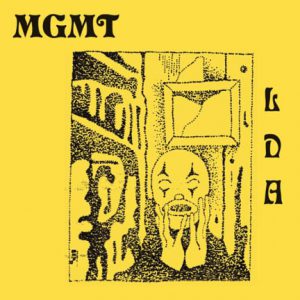
BY MERT ENEY (LAW/IV)
mert.eney@ug.bilkent.edu.tr
MGMT: Little Dark Age
Rating: ★★★★☆
This January, I had the privilege of attending a DJ performance by Andrew VanWyngarden – half of MGMT – while I was in Brooklyn, New York, visiting my brother. The setting was a small underground space much like a post-apocalyptic bunker designed to outlast a nuclear holocaust, the only difference being the large crimson neon sign that read ‘“Dancing Floor Only” over the stairs leading down to the room. The performance got off to an impressive start, a sample-based house set played exclusively from a selection of disco-rooted vinyls, but was abruptly cut short after Andrew appeared more and more discomforted by his situation. He left the stage (or rather, the designated DJ area, since it was a small venue) without any kind of warning, and another DJ quickly took over. This, I believe, is a fitting metaphor for MGMT’s accidentally successful career – they never wanted to be a big band, so they willingly obscured themselves from stardom, leaving without a warning, with growingly opaque albums.

The duo’s debut album, “Oracular Spectacular,” garnered surprising success (commercial as well as critical), and singles like “Time to Pretend,” “Kids” and “Electric Feel” have since become representative of the new millennium’s first indie hits. This – two college kids creating one of the most successful debut albums of the genre – was, of course, never MGMT’s intention. As they became bigger and bigger, playing bigger festivals and turning into a brand-like name as the relentless founding fathers of late ’00s ennui, they also grew weary of the attention. As a result, they released two albums with a soundscape very distinct from that of their debut: 2010’s “Congratulations” and 2013’s “MGMT.” Both albums saw them growing ever more exhausted from their own sound, and creating a new, 70s-influenced psychedelic electronica in surplus amounts to perhaps recompense for the radio air-time they have since received. Both albums were not only commercial flops, but also gathered little critical acclaim – and so MGMT, 10 years out from their debut, returned to true obscurity. The general public has given up and their fans grew tired of following a band that never seemed to answer their calls. That almost-anonymity was expected to continue unless they returned to their original sound.

This is what seems to be the overlying artistic commodity of their brand-new album, “Little Dark Age”: an attempt to accomplish that return without compromising themselves to the media overlords. The album is likely to have a disorienting impact on anyone who has followed their music for the last eight years, in that it has gained a reputation for being much more pop-influenced and radio-friendly. The LP is perhaps a reconciliation between their own sonic vision and the expectations of their fan base – it still has its moments flirting with overwhelming experimentation, but these are broken up by the kind of crowd-pleasing synth arrangements that the band built their “infamous” name on. While the title track is a heavily Goth-influenced banger, songs like “Me and Michael” and “One Thing Left to Try” are very much synthpop songs, almost to a point where they appear to be non-MGMT work, seemingly attributable to any artist other than the two who have been creating something very different for the last eight years.
MGMT are still very much a band making music on their own terms – evangelists in psychedelic research – but this time, they have decided to create something for us, too.
